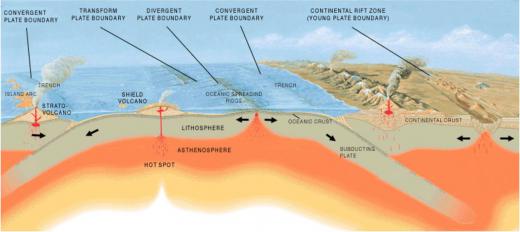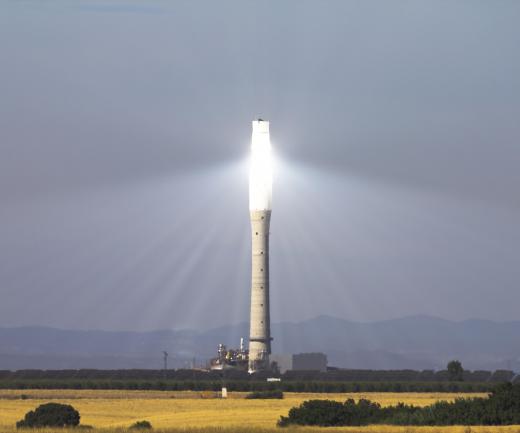What is Thermal Energy?
 Jessica Ellis
Jessica Ellis
The atoms and molecules that make up a substance are in constant motion. This movement is what gives a material its temperature: the more the molecules are moving about, the higher the temperature. Thermal energy is simply the energy possessed by a substance due to the movement of its atoms or molecules. It is important not to confuse this with heat, which is energy that is transferred from one place to another. Thermal energy has long been exploited by humans for cooking, heating, power generation and industry.
Radiation, Conduction and Convection

Heat is defined as energy that is transferred from one region to another, always flowing from a higher to a lower temperature area. It can be transferred by infrared radiation, a form of electromagnetic radiation with a range of wavelengths that lie between radio waves and visible light. This interacts with matter to cause molecules to move about at greater speeds, which is seen as a rise in temperature: the material becomes warm or hot, because energy has been transferred from the source of the radiation to the material that absorbs it. For example, if an object if held near a flame, it becomes hot due to infrared radiation from the flame.

Transfer can also take place by two other methods. In conduction, the movement of molecules in a hot region causes increased movement in cooler areas as the molecules bump into one another. For example, if a metal spoon is held in a flame, the other end of the spoon will eventually become hot.
Convection involves the movement of a region of gas or liquid that is warmer than its surroundings. For example, the Sun heats the ground, which in turn heats the air, which then moves upwards, as the warm air is less dense than the cooler air above. It is convection that drives the world’s weather systems, as warm air from the tropics rises and flows outwards.
Thermal Energy and Matter

Thermal energy can bring about a change in the state of matter. If the molecules in a solid increase their motion sufficiently, it will melt to become a liquid. A further increase will cause the liquid to boil and become a gas, although liquids also tend to evaporate at temperatures well below their boiling points, as some molecules will be moving fast enough to escape the liquid. Since the molecules in a gas are moving more quickly than those in a liquid, a gas has more energy. This is why sweating cools people down: as sweat evaporates, it takes heat away from the body.
Exploiting Thermal Energy

The use of thermal energy, either directly or to generate electricity, drove the industrial revolution. It allowed the large-scale production of iron and steel and produced the steam to drive the turbines used to generate electricity. Humanity has for some time been heavily dependent on the combustion of fossil fuels, such as oil, coal and natural gas, as sources of thermal energy. Concerns about pollution, climate change and non-renewability, however, have generated a lot of interest in alternatives.
One source being exploited is geothermal energy. The Earth has a molten core, which is thought to have a temperature of 5,432-9,032°F (3,000-5,000°C). This high temperature comes partly from heat left over from the formation of the Earth, trapped beneath insulating layers of rock in the crust, and partly from the decay of radioactive elements. Between the core and the crust lies the mantle, a hot, semi-liquid region that drives plate tectonics and volcanic eruptions. There are many “hot spots” on the Earth’s crust where this heat is close to the surface and can be harnessed in various ways.
Geothermal heat can be used either directly, to provide heating for homes, or to generate electricity. Geysers are a ready-made source of hot water, but most geothermal projects involve drilling holes and pumping water into them. The water is heated below the surface and pumped out again to provide energy. Geothermal energy is not, strictly speaking, a renewable energy source, but there is such a huge supply of heat from the core that it will not run out in the foreseeable future.
Although solar energy can be exploited to produce electricity directly through solar panels, another area being explored is solar thermal energy. This involves capturing heat from the Sun to provide power or hot water. This may be used for central heating in homes, where water, or another fluid, is pumped through a container that receives sunlight, raising its temperature. Alternatively, heat from the Sun can be used to drive mechanical devices that generate electricity, or may be focused by convex mirrors in such a way as to provide heat for cooking or other purposes. This idea can also be adopted on a larger scale to boil water that drives a turbine or to build a “solar furnace” that can achieve the extreme temperatures required for some industrial processes.
AS FEATURED ON:
AS FEATURED ON:














Discussion Comments
Thermal energy is the energy particles within a body or system acquires due to an increase in temperature and it results in the movement of these particles from one point to the other, thermal energy is influence by external factors. Chemical energy is the energy the particles in a body or system acquire due to the breakdown of complex chemical substance or the reaction of chemical elements within the particles or the body and it does not need any external influence to start the process
The core of the earth contains a tremendous amount of clean, sustainable thermal energy. Is there any practical way to harness it and use it in the power grid? Is anybody using this as a power source now?
I remember it being described very specifically and it made it seem so feasible and logical. It's kind of strange that this mundane part of the book stands out so much to me, but it does.
I didn't know that there was such thing as polar thermal power!
What are the risks involved in thermal energy?
What is a example of thermal energy?
What is the simplest definition of thermal energy there is, apart from heat?
I think thermal energy is awesome! Thought: what is one common way and one uncommon way of producing thermal energy?
Is thermal energy the total or average kinetic energy?
i have three questions: 1) What's the best absorber of thermal energy?
2) whats the best reflector of thermal energy?
3) whats the best emitter of thermal energy?
You can only use these to answer the question: white, shiny black, silver, matte black.
Thermal energy is not chemical energy. Thermal energy is the internal energy of a substance; the sum of the random kinetic energies and potential energies of all the particles (atoms) that make up the substance. Heat is not necessarily the same as thermal energy.
Heat is the thermal energy that is transferred between two systems when at different temperatures. An isolated object may have thermal energy, but there is no heat in the formal sense of the word. When you rub your hands together, you do not generate heat because there is no temperature difference between your hands. Friction increases the thermal energy of your hands.
thermal, as we all know, is something related to heat. in the same way, thermal energy in any form i.e. due to sun or carbon rich fossil fuels, combustion and geothermal energy all are potential sources of thermal energy. -kriti
At some degree I guess it is. Chemical reactions of sorts create heat, and therefore thermal energy. But, in other ways thermal energy and chemical energy are different.
Is thermal energy a type of Chemical Energy?
Post your comments